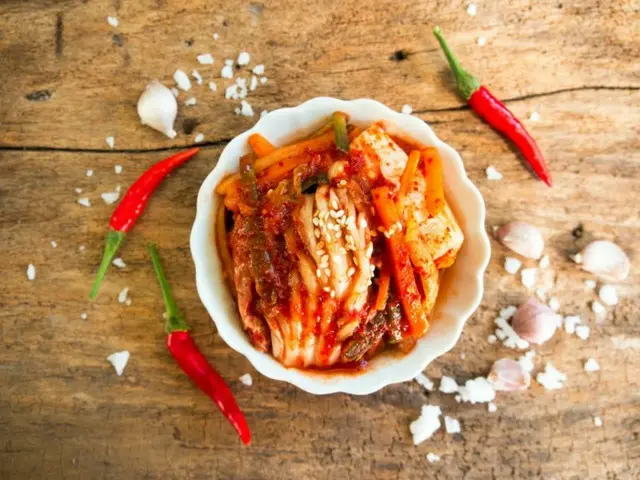In Korean households, the culture of "kimjang" has taken root, where family and relatives gather together to make kimchi before winter, when vegetables become scarce. However, as urbanization and the trend toward nuclear families progressed,
Due to this, opportunities to make kimchi are becoming fewer. The consumption of kimchi by Koreans is also said to be on the decline. Furthermore, due to the extreme heat this summer, the prices of vegetables, including Chinese cabbage, have risen.
There are concerns that if the extreme heat continues every year in the future, Korean-made Chinese cabbage kimchi may become unavailable in the future.
Professor Kyung-duk pointed out that some Chinese internet users are spreading kimchi as a national food. He wrote on his SNS that "Chinese internet users should respect the culture of other countries first.
"Kimchi Day" was established in 2020 by the Korea Agro-Fisheries and Food Trade Corporation in hopes of promoting kimchi culture. The reason for choosing November 22nd is that "kimchi is made with just one ingredient.
The name comes from the fact that one (11) comes together and shows 22 different (22) effects. Also, November is the best time to make kimchi, as Chinese cabbage, an ingredient in kimchi, is in season.
The Ministry of Agriculture, Food and Rural Affairs held a commemorative ceremony in Seoul on the same day. Minister Song Miryon said, "The kimchi industry has recently become a major player in the country.
"We are seeing remarkable growth and change both at home and abroad," he said, adding, "We will actively support the sustainable growth of the kimchi industry and promote the spirit of sharing and community culture through kimchi both at home and abroad."
After the ceremony, a women's association made up of women who married Korean men from different countries participated and experienced making kimchi.
Kimchi is a Korean food from Seoul. It is an indispensable vegetable on the dinner table and is also sold in restaurants.
It is usually served with the main dish. The culture of "kimjang" has been deeply rooted in Korean households for a long time. The corporation's website introduces the history of kimjang.
According to the report, the 1241 book "Dongguk Yi Sang-gukjip" (The Book of the Dongguk Yi Sang-guk), which states that radishes were pickled in salt to prepare for winter, did not seem to have become a major event until around the 17th century.
The corporation explains that in the mid-18th century, nobles began making kimchi to survive the winter, and as this class of people began making kimchi at the same time each year, this led to the development of kimjang.
As kimchi became popular among the upper classes, it soon spread to the common people, and with the popularity of Chinese cabbage kimchi, kimchi became a habit.
In the 20th century, kimchi making spread regardless of class, and it became established as a uniquely Korean culture. In 2013, kimchi making culture was recognized by the UNESCO.
Kimchi is a traditional Korean dish made with ingredients from the ancient Chinese medicine, which is said to have been used in cooking.
The consumption of kimchi by Koreans has also been declining in recent years, which is a serious issue from the perspective of cultural inheritance as the "home of kimchi."
On the other hand, due to the recent Korean wave and health consciousness, consumption of kimchi overseas is increasing. From January to October this year, the amount of kimchi exported from Korea was 134.7 million dollars (about 20.848 billion yen).
The largest import departure was from Japan, followed by the United States, the Netherlands, the United Kingdom, and Australia.
This summer, South Korea experienced record heat waves, which led to a surge in the prices of vegetables, including Chinese cabbage.
The cabbage is said to be best grown at 18-20 degrees Celsius, and the heat this summer has had a particularly large impact on Chinese cabbage among other vegetables, causing soil rot and other diseases that cause Chinese cabbage to wither and die.
Infectious diseases have also spread. If the heatwaves continue every year, there are fears that in the future Korean cabbage kimchi may become inedible. The Rural Development Administration's climate change scenario predicts that cabbage will become
It is predicted that the area of land under cultivation will continue to shrink, and that it will be impossible to cultivate in highland areas by 2090. Given the current situation in which global warming is not being stopped, it will be necessary to develop varieties that can be grown in warm climates in the future.
Improvements will be necessary. There have been a series of hot topics that have caused headaches for the "Kimchi master country," but there are also incidents that have further angered Koreans.
Professor Seo Kyung-duk claims that China is trying to make kimchi its own culture. "I recently received information from an internet user and after checking, I found that Chinese social media sites were posting comments such as 'kimchi' and 'China.'
"Many videos were posted with the hashtag, not only on Chinese social media, but also on YouTube Shorts, Instagram Reels, TikTok, etc.
"The situation is serious as it has spread to many places, including Tok," he said. In the past, there have been many disputes over the origin of kimchi between China and Korea.
In 2020, Chinese media reported that "Kimchi is based on Chinese Pao cai," sparking a major controversy.
The decline of Kimjang, the decrease in Koreans' consumption of Kimchi, the rise in the price of Chinese cabbage,
And then there's the dispute between China and Korea over kimchi. Korea, the "homeland of kimchi," is currently facing a mountain of headaches.
2024/11/27 12:14 KST
Copyrights(C)wowkorea.jp 5

